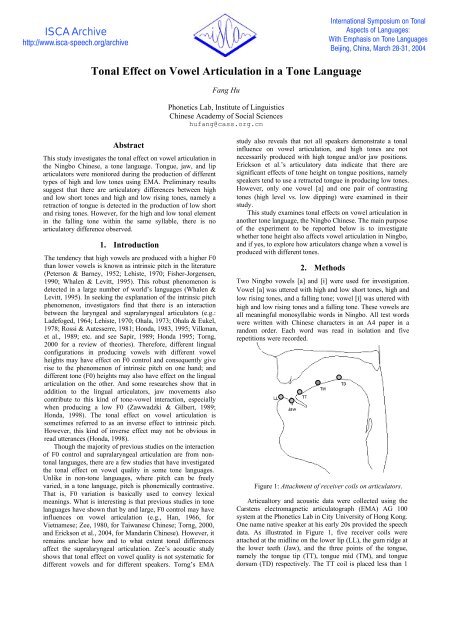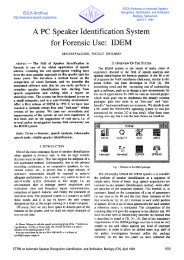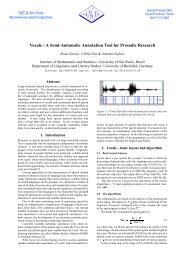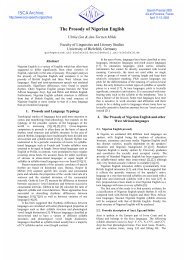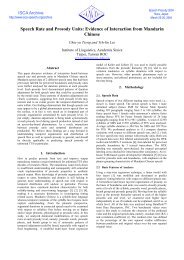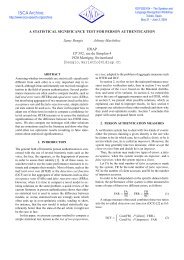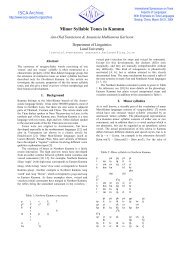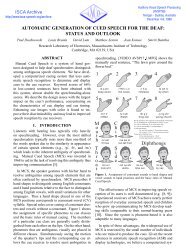Tonal Effect on Vowel Articulation in a Tone Language - ISCA ...
Tonal Effect on Vowel Articulation in a Tone Language - ISCA ...
Tonal Effect on Vowel Articulation in a Tone Language - ISCA ...
Create successful ePaper yourself
Turn your PDF publications into a flip-book with our unique Google optimized e-Paper software.
<strong>ISCA</strong> Archive<br />
http://www.isca-speech.org/archive<br />
Internati<strong>on</strong>al Symposium <strong>on</strong> <str<strong>on</strong>g>T<strong>on</strong>al</str<strong>on</strong>g><br />
Aspects of <strong>Language</strong>s:<br />
With Emphasis <strong>on</strong> T<strong>on</strong>e <strong>Language</strong>s<br />
Beij<strong>in</strong>g, Ch<strong>in</strong>a, March 28-31, 2004<br />
<str<strong>on</strong>g>T<strong>on</strong>al</str<strong>on</strong>g> <str<strong>on</strong>g>Effect</str<strong>on</strong>g> <strong>on</strong> <strong>Vowel</strong> Articulati<strong>on</strong> <strong>in</strong> a T<strong>on</strong>e <strong>Language</strong><br />
Fang Hu<br />
Ph<strong>on</strong>etics Lab, Institute of L<strong>in</strong>guistics<br />
Ch<strong>in</strong>ese Academy of Social Sciences<br />
hufang@cass.org.cn<br />
Abstract<br />
This study <strong>in</strong>vestigates the t<strong>on</strong>al effect <strong>on</strong> vowel articulati<strong>on</strong> <strong>in</strong><br />
the N<strong>in</strong>gbo Ch<strong>in</strong>ese, a t<strong>on</strong>e language. T<strong>on</strong>gue, jaw, and lip<br />
articulators were m<strong>on</strong>itored dur<strong>in</strong>g the producti<strong>on</strong> of different<br />
types of high and low t<strong>on</strong>es us<strong>in</strong>g EMA. Prelim<strong>in</strong>ary results<br />
suggest that there are articulatory differences between high<br />
and low short t<strong>on</strong>es and high and low ris<strong>in</strong>g t<strong>on</strong>es, namely a<br />
retracti<strong>on</strong> of t<strong>on</strong>gue is detected <strong>in</strong> the producti<strong>on</strong> of low short<br />
and ris<strong>in</strong>g t<strong>on</strong>es. However, for the high and low t<strong>on</strong>al element<br />
<strong>in</strong> the fall<strong>in</strong>g t<strong>on</strong>e with<strong>in</strong> the same syllable, there is no<br />
articulatory difference observed.<br />
1. Introducti<strong>on</strong><br />
The tendency that high vowels are produced with a higher F0<br />
than lower vowels is known as <strong>in</strong>tr<strong>in</strong>sic pitch <strong>in</strong> the literature<br />
(Peters<strong>on</strong> & Barney, 1952; Lehiste, 1970; Fisher-Jorgensen,<br />
1990; Whalen & Levitt, 1995). This robust phenomen<strong>on</strong> is<br />
detected <strong>in</strong> a large number of world’s languages (Whalen &<br />
Levitt, 1995). In seek<strong>in</strong>g the explanati<strong>on</strong> of the <strong>in</strong>tr<strong>in</strong>sic pitch<br />
phenomen<strong>on</strong>, <strong>in</strong>vestigators f<strong>in</strong>d that there is an <strong>in</strong>teracti<strong>on</strong><br />
between the laryngeal and supralaryngeal articulators (e.g.:<br />
Ladefoged, 1964; Lehiste, 1970; Ohala, 1973; Ohala & Eukel,<br />
1978; Rossi & Autesserre, 1981; H<strong>on</strong>da, 1983, 1995; Vilkman,<br />
et al., 1989; etc. and see Sapir, 1989; H<strong>on</strong>da 1995; Torng,<br />
2000 for a review of theories). Therefore, different l<strong>in</strong>gual<br />
c<strong>on</strong>figurati<strong>on</strong>s <strong>in</strong> produc<strong>in</strong>g vowels with different vowel<br />
heights may have effect <strong>on</strong> F0 c<strong>on</strong>trol and c<strong>on</strong>sequently give<br />
rise to the phenomen<strong>on</strong> of <strong>in</strong>tr<strong>in</strong>sic pitch <strong>on</strong> <strong>on</strong>e hand; and<br />
different t<strong>on</strong>e (F0) heights may also have effect <strong>on</strong> the l<strong>in</strong>gual<br />
articulati<strong>on</strong> <strong>on</strong> the other. And some researches show that <strong>in</strong><br />
additi<strong>on</strong> to the l<strong>in</strong>gual articulators, jaw movements also<br />
c<strong>on</strong>tribute to this k<strong>in</strong>d of t<strong>on</strong>e-vowel <strong>in</strong>teracti<strong>on</strong>, especially<br />
when produc<strong>in</strong>g a low F0 (Zawwadzki & Gilbert, 1989;<br />
H<strong>on</strong>da, 1998). The t<strong>on</strong>al effect <strong>on</strong> vowel articulati<strong>on</strong> is<br />
sometimes referred to as an <strong>in</strong>verse effect to <strong>in</strong>tr<strong>in</strong>sic pitch.<br />
However, this k<strong>in</strong>d of <strong>in</strong>verse effect may not be obvious <strong>in</strong><br />
read utterances (H<strong>on</strong>da, 1998).<br />
Though the majority of previous studies <strong>on</strong> the <strong>in</strong>teracti<strong>on</strong><br />
of F0 c<strong>on</strong>trol and supralaryngeal articulati<strong>on</strong> are from n<strong>on</strong>t<strong>on</strong>al<br />
languages, there are a few studies that have <strong>in</strong>vestigated<br />
the t<strong>on</strong>al effect <strong>on</strong> vowel quality <strong>in</strong> some t<strong>on</strong>e languages.<br />
Unlike <strong>in</strong> n<strong>on</strong>-t<strong>on</strong>e languages, where pitch can be freely<br />
varied, <strong>in</strong> a t<strong>on</strong>e language, pitch is ph<strong>on</strong>emically c<strong>on</strong>trastive.<br />
That is, F0 variati<strong>on</strong> is basically used to c<strong>on</strong>vey lexical<br />
mean<strong>in</strong>gs. What is <strong>in</strong>terest<strong>in</strong>g is that previous studies <strong>in</strong> t<strong>on</strong>e<br />
languages have shown that by and large, F0 c<strong>on</strong>trol may have<br />
<strong>in</strong>fluences <strong>on</strong> vowel articulati<strong>on</strong> (e.g., Han, 1966, for<br />
Vietnamese; Zee, 1980, for Taiwanese Ch<strong>in</strong>ese; Torng, 2000,<br />
and Ericks<strong>on</strong> et al., 2004, for Mandar<strong>in</strong> Ch<strong>in</strong>ese). However, it<br />
rema<strong>in</strong>s unclear how and to what extent t<strong>on</strong>al differences<br />
affect the supralaryngeal articulati<strong>on</strong>. Zee’s acoustic study<br />
shows that t<strong>on</strong>al effect <strong>on</strong> vowel quality is not systematic for<br />
different vowels and for different speakers. Torng’s EMA<br />
study also reveals that not all speakers dem<strong>on</strong>strate a t<strong>on</strong>al<br />
<strong>in</strong>fluence <strong>on</strong> vowel articulati<strong>on</strong>, and high t<strong>on</strong>es are not<br />
necessarily produced with high t<strong>on</strong>gue and/or jaw positi<strong>on</strong>s.<br />
Ericks<strong>on</strong> et al.’s articulatory data <strong>in</strong>dicate that there are<br />
significant effects of t<strong>on</strong>e height <strong>on</strong> t<strong>on</strong>gue positi<strong>on</strong>s, namely<br />
speakers tend to use a retracted t<strong>on</strong>gue <strong>in</strong> produc<strong>in</strong>g low t<strong>on</strong>es.<br />
However, <strong>on</strong>ly <strong>on</strong>e vowel [a] and <strong>on</strong>e pair of c<strong>on</strong>trast<strong>in</strong>g<br />
t<strong>on</strong>es (high level vs. low dipp<strong>in</strong>g) were exam<strong>in</strong>ed <strong>in</strong> their<br />
study.<br />
This study exam<strong>in</strong>es t<strong>on</strong>al effects <strong>on</strong> vowel articulati<strong>on</strong> <strong>in</strong><br />
another t<strong>on</strong>e language, the N<strong>in</strong>gbo Ch<strong>in</strong>ese. The ma<strong>in</strong> purpose<br />
of the experiment to be reported below is to <strong>in</strong>vestigate<br />
whether t<strong>on</strong>e height also affects vowel articulati<strong>on</strong> <strong>in</strong> N<strong>in</strong>gbo,<br />
and if yes, to explore how articulators change when a vowel is<br />
produced with different t<strong>on</strong>es.<br />
2. Methods<br />
Two N<strong>in</strong>gbo vowels [a] and [i] were used for <strong>in</strong>vestigati<strong>on</strong>.<br />
<strong>Vowel</strong> [a] was uttered with high and low short t<strong>on</strong>es, high and<br />
low ris<strong>in</strong>g t<strong>on</strong>es, and a fall<strong>in</strong>g t<strong>on</strong>e; vowel [i] was uttered with<br />
high and low ris<strong>in</strong>g t<strong>on</strong>es and a fall<strong>in</strong>g t<strong>on</strong>e. These vowels are<br />
all mean<strong>in</strong>gful m<strong>on</strong>osyllabic words <strong>in</strong> N<strong>in</strong>gbo. All test words<br />
were written with Ch<strong>in</strong>ese characters <strong>in</strong> an A4 paper <strong>in</strong> a<br />
random order. Each word was read <strong>in</strong> isolati<strong>on</strong> and five<br />
repetiti<strong>on</strong>s were recorded.<br />
Figure 1: Attachment of receiver coils <strong>on</strong> articulators.<br />
Articualtory and acoustic data were collected us<strong>in</strong>g the<br />
Carstens electromagnetic articulatograph (EMA) AG 100<br />
system at the Ph<strong>on</strong>etics Lab <strong>in</strong> City University of H<strong>on</strong>g K<strong>on</strong>g.<br />
One name native speaker at his early 20s provided the speech<br />
data. As illustrated <strong>in</strong> Figure 1, five receiver coils were<br />
attached at the midl<strong>in</strong>e <strong>on</strong> the lower lip (LL), the gum ridge at<br />
the lower teeth (Jaw), and the three po<strong>in</strong>ts of the t<strong>on</strong>gue,<br />
namely the t<strong>on</strong>gue tip (TT), t<strong>on</strong>gue mid (TM), and t<strong>on</strong>gue<br />
dorsum (TD) respectively. The TT coil is placed less than 1
cm to the t<strong>on</strong>gue tip, the TM coil is about 3 cm to the TT coil,<br />
and the TD coils is about 6 cm to the t<strong>on</strong>gue tip.<br />
The Carstens W<strong>in</strong>Pact software package was used <strong>in</strong><br />
process<strong>in</strong>g and analyz<strong>in</strong>g the EMA data. Before serious<br />
analysis, the raw articulatory data was down sampled from<br />
500Hz to 250 Hz and smoothed, and was then rotated so that<br />
the new horiz<strong>on</strong>tal (x) axis was parallel to the subject’s<br />
occlusal plane. Both articulatory and acoustic measurements<br />
of high and low short t<strong>on</strong>es of vowel [a] and high and low<br />
ris<strong>in</strong>g t<strong>on</strong>es of vowels [a] and [i] were made at the midpo<strong>in</strong>t<br />
of vowel durati<strong>on</strong>. And the articulati<strong>on</strong> of the high short t<strong>on</strong>e<br />
and high ris<strong>in</strong>g t<strong>on</strong>e is compared to that of the low short t<strong>on</strong>e<br />
and low ris<strong>in</strong>g t<strong>on</strong>e respectively to see if there is any<br />
difference. For the fall<strong>in</strong>g t<strong>on</strong>e, articulatory differences were<br />
exam<strong>in</strong>ed with<strong>in</strong> the syllable. And the po<strong>in</strong>t at 10% of vowel<br />
durati<strong>on</strong> was selected as the measure po<strong>in</strong>t of high t<strong>on</strong>e, and<br />
the po<strong>in</strong>t at 90% of durati<strong>on</strong> as the measure po<strong>in</strong>t of low t<strong>on</strong>e.<br />
3. Results and discussi<strong>on</strong><br />
Results of the mean F0 values (with the Standard Deviati<strong>on</strong>s<br />
<strong>in</strong> parentheses right after the means) <strong>on</strong> the measure po<strong>in</strong>ts of<br />
different t<strong>on</strong>es are shown <strong>in</strong> Table 1. As can be seen from the<br />
table, all the high t<strong>on</strong>al po<strong>in</strong>ts have a greater F0 value than the<br />
corresp<strong>on</strong>d<strong>in</strong>g low po<strong>in</strong>ts. The difference between the high<br />
and low t<strong>on</strong>al elements <strong>in</strong> the fall<strong>in</strong>g t<strong>on</strong>e is the greatest<br />
(about 100 Hz). The difference between a high and low short<br />
t<strong>on</strong>e is as great as about 40 Hz. And the difference between<br />
high and low ris<strong>in</strong>g t<strong>on</strong>es is the smallest (about 15-20 Hz).<br />
Table 1: Mean F0 (<strong>in</strong> Hz) of different t<strong>on</strong>es<br />
<strong>Vowel</strong> T<strong>on</strong>e High Low<br />
short 174 (4) 130 (7)<br />
[a] ris<strong>in</strong>g 137 (2) 122 (3)<br />
fall<strong>in</strong>g 176 (5) 73 (9)<br />
[i]<br />
ris<strong>in</strong>g 150 (4) 128 (6)<br />
fall<strong>in</strong>g 177 (5) 73 (10)<br />
3.1. Short t<strong>on</strong>es<br />
As shown <strong>in</strong> Figure 2 1 , mean positi<strong>on</strong>s of TM and TT <strong>in</strong> high<br />
short t<strong>on</strong>e are similar to those <strong>in</strong> low short t<strong>on</strong>e. The ma<strong>in</strong><br />
differences between the high and low ris<strong>in</strong>g t<strong>on</strong>e are the<br />
positi<strong>on</strong>s of TD and Jaw and LL.<br />
Articulator Positi<strong>on</strong> Y<br />
135<br />
[a]<br />
130<br />
125<br />
120<br />
115<br />
110<br />
105<br />
100<br />
95<br />
90<br />
85<br />
80<br />
high t<strong>on</strong>e<br />
low t<strong>on</strong>e<br />
Palate C<strong>on</strong>tour<br />
60 65 70 75 80 85 90 95 100 105 110 115<br />
Articulator Positi<strong>on</strong> X<br />
Figure 2: Mean articulator positi<strong>on</strong>s (mm) of vowel [a] <strong>in</strong><br />
High and Low short t<strong>on</strong>es.<br />
Figure 3 shows the TD positi<strong>on</strong>s <strong>in</strong> the high and low short<br />
t<strong>on</strong>es, with a 2-sigma c<strong>on</strong>fidence ellipse superimposed <strong>on</strong> the<br />
1 In all figures <strong>in</strong> this paper, the speaker is fac<strong>in</strong>g to the left.<br />
data po<strong>in</strong>ts. From the figure we can see that the TD po<strong>in</strong>ts <strong>in</strong><br />
low short t<strong>on</strong>e are comparatively higher (about 1.4 mm <strong>on</strong><br />
average) and more posterior (about 0.5 mm <strong>on</strong> average) than<br />
those <strong>in</strong> high short t<strong>on</strong>e. That is, the t<strong>on</strong>gue dorsum is<br />
relatively more raised and retracted <strong>in</strong> produc<strong>in</strong>g the low short<br />
t<strong>on</strong>e.<br />
T<strong>on</strong>gue Dorsum Y<br />
122<br />
121<br />
120<br />
119<br />
118<br />
117<br />
Solid Circles: H<br />
Open Circles: L<br />
116<br />
108 109 110 111 112 113 114<br />
T<strong>on</strong>gue Dorsum X<br />
Figure 3: TD positi<strong>on</strong>s (mm) of vowel [a] <strong>in</strong> High and Low<br />
short t<strong>on</strong>es.<br />
Jaw Y<br />
85<br />
84<br />
83<br />
82<br />
81<br />
80<br />
79<br />
78<br />
77<br />
Solid Circles: H<br />
Open Circles: L<br />
76<br />
75 76 77 78 79<br />
Jaw X<br />
Lower Lip Y<br />
83<br />
82<br />
81<br />
80<br />
79<br />
78<br />
77<br />
76<br />
75<br />
Solid Circles: H<br />
Open Circles: L<br />
74<br />
67 68 69 70 71 72<br />
Lower Lip X<br />
Figure 4: Jaw (Left) and Lower Lip (right) positi<strong>on</strong>s (mm)<br />
of vowel [a] <strong>in</strong> High and Low short t<strong>on</strong>es.<br />
Figure 4 shows Jaw and LL positi<strong>on</strong>s <strong>in</strong> the producti<strong>on</strong> of<br />
high and low short t<strong>on</strong>es. It can be seen from the figure that<br />
the jaw and lower lip is also slightly more retracted <strong>in</strong> the<br />
producti<strong>on</strong> of low short t<strong>on</strong>es vis-à-vis that of high short t<strong>on</strong>es.<br />
And it is <strong>in</strong>terest<strong>in</strong>g to note that the ellipses of data po<strong>in</strong>ts <strong>in</strong><br />
the low short t<strong>on</strong>e have a different orientati<strong>on</strong> to those <strong>in</strong> the<br />
high short t<strong>on</strong>e. In the producti<strong>on</strong> of high short t<strong>on</strong>e, the<br />
major variance axis is distributed al<strong>on</strong>g the high-low<br />
dimensi<strong>on</strong>, whereas <strong>in</strong> the low short t<strong>on</strong>e producti<strong>on</strong>, a<br />
horiz<strong>on</strong>tal distributi<strong>on</strong> of the major variance is detected,<br />
which implies that the jaw and lower lip are more variable<br />
horiz<strong>on</strong>tally <strong>in</strong> the low t<strong>on</strong>e producti<strong>on</strong>.<br />
3.2. Ris<strong>in</strong>g t<strong>on</strong>es<br />
Figure 5 shows the mean articulator positi<strong>on</strong>s of high and low<br />
ris<strong>in</strong>g t<strong>on</strong>es <strong>in</strong> vowels [a] and [i]. For the vowel [a], the mean<br />
TD positi<strong>on</strong> <strong>in</strong> low ris<strong>in</strong>g t<strong>on</strong>e doesn’t show a tendency of<br />
retracti<strong>on</strong> as <strong>in</strong> low short t<strong>on</strong>e, if judged from the positi<strong>on</strong><br />
difference <strong>in</strong> the x-axis; rather, the mean TD positi<strong>on</strong> <strong>in</strong> high<br />
ris<strong>in</strong>g t<strong>on</strong>e occupies a relatively back positi<strong>on</strong>. However, the<br />
TD positi<strong>on</strong> for the low t<strong>on</strong>e is still higher (about 1 mm) than<br />
for the high t<strong>on</strong>e. And this is also manifested from a closer<br />
exam<strong>in</strong>ati<strong>on</strong> of TD po<strong>in</strong>ts and ellipse of vowel [a], as shown<br />
<strong>in</strong> Figure 6. Moreover, the sampled t<strong>on</strong>gue c<strong>on</strong>tour for the<br />
low t<strong>on</strong>e <strong>in</strong> Figure 5 is somewhat retracted <strong>in</strong> comparis<strong>on</strong> to<br />
the high t<strong>on</strong>e. And as shown <strong>in</strong> Figure 7 and 8, the TM<br />
positi<strong>on</strong> is slightly lower and the TT positi<strong>on</strong> is both lower
and more posterior <strong>in</strong> low ris<strong>in</strong>g t<strong>on</strong>e. So, it is still tenable to<br />
summarize that there is t<strong>on</strong>gue retracti<strong>on</strong> <strong>in</strong> the producti<strong>on</strong> of<br />
low ris<strong>in</strong>g t<strong>on</strong>e <strong>in</strong> vowel [a]. However, the raised TD positi<strong>on</strong><br />
<strong>in</strong>dicates that the retracti<strong>on</strong> may not always be manifested <strong>in</strong><br />
the horiz<strong>on</strong>tal t<strong>on</strong>gue positi<strong>on</strong>al difference; rather it is very<br />
likely that the retracti<strong>on</strong> is executed through the movement of<br />
the t<strong>on</strong>gue dorsum towards the velum regi<strong>on</strong>.<br />
Articulator Positi<strong>on</strong> Y<br />
T<strong>on</strong>gue Dorsum Y<br />
T<strong>on</strong>gue Mid Y<br />
T<strong>on</strong>gue Tip Y<br />
124<br />
123<br />
122<br />
121<br />
120<br />
119<br />
135<br />
[a] ris<strong>in</strong>g t<strong>on</strong>e<br />
130<br />
125<br />
120<br />
115<br />
110<br />
105<br />
100<br />
95<br />
90<br />
85<br />
80<br />
75<br />
high ris<strong>in</strong>g<br />
low ris<strong>in</strong>g<br />
Palate C<strong>on</strong>tour<br />
60 65 70 75 80 85 90 95 100 105 110 115<br />
Articulator Positi<strong>on</strong> X<br />
Articulator Positi<strong>on</strong> Y<br />
135<br />
[i] ris<strong>in</strong>g t<strong>on</strong>e<br />
130<br />
125<br />
120<br />
115<br />
110<br />
105<br />
100<br />
95<br />
90<br />
85<br />
80<br />
75<br />
high ris<strong>in</strong>g<br />
low ris<strong>in</strong>g<br />
Palate C<strong>on</strong>tour<br />
60 65 70 75 80 85 90 95 100 105 110 115<br />
Articulator Positi<strong>on</strong> X<br />
Figure 5: Mean articulator positi<strong>on</strong>s (mm) of vowel<br />
[a](left) and [i] (right) <strong>in</strong> High and Low ris<strong>in</strong>g t<strong>on</strong>es.<br />
Solid Circles: H<br />
Open Circles: L<br />
118<br />
107 108 109 110 111 112 113<br />
T<strong>on</strong>gue Dorsum X<br />
120<br />
119<br />
118<br />
117<br />
116<br />
115<br />
T<strong>on</strong>gue Dorsum Y<br />
123<br />
122<br />
121<br />
120<br />
119<br />
118<br />
Solid Circles: H<br />
117<br />
Open Circles: L<br />
116<br />
101 102 103 104 105 106<br />
T<strong>on</strong>gue Dorsum X<br />
Figure 6: TD positi<strong>on</strong>s (mm) of vowel [a](left) and [i]<br />
(right) <strong>in</strong> High and Low ris<strong>in</strong>g t<strong>on</strong>es.<br />
Solid Circles: H<br />
Open Circles: L<br />
114<br />
94 96 98 100 102 104<br />
T<strong>on</strong>gue Mid X<br />
103<br />
102<br />
101<br />
100<br />
99<br />
98<br />
97<br />
96<br />
95<br />
T<strong>on</strong>gue Mid Y<br />
131<br />
130<br />
129<br />
Solid Circles: H<br />
Open Circles: L<br />
128<br />
86 87 88 89 90 91<br />
T<strong>on</strong>gue Mid X<br />
Figure 7: TM positi<strong>on</strong>s (mm) of vowel [a](left) and [i]<br />
(right) <strong>in</strong> High and Low ris<strong>in</strong>g t<strong>on</strong>es.<br />
94<br />
Solid Circles: H<br />
93<br />
Open Circles: L<br />
92<br />
81 82 83 84 85 86 87<br />
T<strong>on</strong>gue Tip X<br />
T<strong>on</strong>gue Tip Y<br />
112<br />
111<br />
110<br />
109<br />
108<br />
Solid Circles: H<br />
Open Circles: L<br />
107<br />
72 73 74 75 76 77<br />
T<strong>on</strong>gue Tip X<br />
Figure 8: TT positi<strong>on</strong>s (mm) of vowel [a](left) and [i]<br />
(right) <strong>in</strong> High and Low ris<strong>in</strong>g t<strong>on</strong>es.<br />
Regard<strong>in</strong>g the vowel [i], all TD, TM and TT data show a<br />
clearer picture of t<strong>on</strong>gue retracti<strong>on</strong>. However, it should be<br />
admitted that the effect is rather weak. As can be seen from<br />
Figure 5, the overall sampled t<strong>on</strong>gue c<strong>on</strong>tour of [i] is different<br />
from that of [a], because for [i], TM is the pr<strong>in</strong>cipal articulator<br />
po<strong>in</strong>t. As shown <strong>in</strong> Figure 7, TM po<strong>in</strong>ts of low ris<strong>in</strong>g t<strong>on</strong>e<br />
occupy a slightly more posterior positi<strong>on</strong> than those of high<br />
ris<strong>in</strong>g t<strong>on</strong>e. And the difference is about 0.6 mm <strong>on</strong> average.<br />
The TD po<strong>in</strong>ts of low ris<strong>in</strong>g t<strong>on</strong>e are also observed slightly<br />
retracted (about 0.7 mm <strong>on</strong> average), as shown <strong>in</strong> Figure 6.<br />
And the retracti<strong>on</strong> is also manifested from the TT po<strong>in</strong>ts. As<br />
can be seen from figure 8, TT po<strong>in</strong>ts are comparatively higher<br />
(about 0.8 mm <strong>on</strong> average) <strong>in</strong> low ris<strong>in</strong>g t<strong>on</strong>e than <strong>in</strong> high<br />
ris<strong>in</strong>g t<strong>on</strong>e. It can serves as an evidence of retracti<strong>on</strong>, because<br />
the rais<strong>in</strong>g of the t<strong>on</strong>gue tip can be expla<strong>in</strong>ed as a<br />
c<strong>on</strong>sequence of the retracti<strong>on</strong> of the arched t<strong>on</strong>gue.<br />
Figure 9 shows Jaw and LL positi<strong>on</strong>s of vowel [a] <strong>in</strong> high<br />
and low ris<strong>in</strong>g t<strong>on</strong>es. It is clear from the figure that the jaw<br />
and lower lip positi<strong>on</strong> <strong>in</strong> low ris<strong>in</strong>g t<strong>on</strong>e is much lower and<br />
more posterior than <strong>in</strong> high ris<strong>in</strong>g t<strong>on</strong>e. For the jaw, the<br />
difference is about 3.3 mm <strong>on</strong> average of height and about 1.7<br />
mm <strong>on</strong> average of backness. This <strong>in</strong>dicates that <strong>in</strong> the low<br />
ris<strong>in</strong>g t<strong>on</strong>e producti<strong>on</strong>, the jaw is not <strong>on</strong>ly retracted but also<br />
lowered.<br />
Jaw Y<br />
83<br />
82<br />
81<br />
80<br />
79<br />
78<br />
77<br />
76<br />
75<br />
74<br />
73<br />
Solid Circles: H<br />
Open Circles: L<br />
72<br />
75 76 77 78 79 80 81<br />
Jaw X<br />
Lower Lip Y<br />
82<br />
81<br />
80<br />
79<br />
78<br />
77<br />
76<br />
75<br />
74<br />
Solid Circles: H<br />
73<br />
Open Circles: L<br />
72<br />
67 68 69 70 71 72 73<br />
Lower Lip X<br />
Figure 9: Jaw (Left) and Lower Lip (right) positi<strong>on</strong>s (mm)<br />
of vowel [a] <strong>in</strong> High and Low ris<strong>in</strong>g t<strong>on</strong>es.<br />
However, <strong>in</strong> the producti<strong>on</strong> of vowel [i], there is no jaw or<br />
lower lip lower<strong>in</strong>g detected for the low ris<strong>in</strong>g t<strong>on</strong>e, as<br />
shown <strong>in</strong> Figure 10. Actually, there is rarely jaw difference<br />
between the low and high ris<strong>in</strong>g t<strong>on</strong>e. What of <strong>in</strong>terest is<br />
that the LL positi<strong>on</strong> is relatively retracted (about 0.9 mm <strong>on</strong><br />
average) <strong>in</strong> low ris<strong>in</strong>g t<strong>on</strong>e. This implies that the Jaw and<br />
LL comp<strong>on</strong>ents are somehow c<strong>on</strong>trolled <strong>in</strong>dependently to<br />
the l<strong>in</strong>gual comp<strong>on</strong>ent. And the jaw and lower lip may or<br />
may not perform <strong>in</strong> accord with the t<strong>on</strong>gue.<br />
Jaw Y<br />
93<br />
92<br />
91<br />
Solid Circles: H<br />
Open Circles: L<br />
90<br />
68 69 70 71<br />
Jaw X<br />
Lower Lip Y<br />
91<br />
90<br />
89<br />
88<br />
87<br />
86<br />
85<br />
84<br />
Solid Circles: H<br />
Open Circles: L<br />
83<br />
61 62 63 64 65<br />
Lower Lip X<br />
Figure 10: Jaw (Left) and Lower Lip (right) positi<strong>on</strong>s (mm)<br />
of vowel [i] <strong>in</strong> High and Low ris<strong>in</strong>g t<strong>on</strong>es.<br />
3.3. High and low t<strong>on</strong>al elements <strong>in</strong> fall<strong>in</strong>g t<strong>on</strong>es<br />
Figure 11 shows the mean articulator positi<strong>on</strong>s of high and<br />
low t<strong>on</strong>al elements <strong>in</strong> the fall<strong>in</strong>g t<strong>on</strong>e for vowels [a] and [i].<br />
From the figure we can see that for both vowels [a] and [i],<br />
data exhibits no noticeable difference of the t<strong>on</strong>gue positi<strong>on</strong><br />
between the high and low t<strong>on</strong>al elements <strong>in</strong> the fall<strong>in</strong>g t<strong>on</strong>e.<br />
And for the vowel [i], the Jaw and LL positi<strong>on</strong>s for the high<br />
t<strong>on</strong>al element are nearly identical to those for the low t<strong>on</strong>al<br />
element <strong>in</strong> the fall<strong>in</strong>g t<strong>on</strong>e. Regard<strong>in</strong>g the vowel [a], the Jaw<br />
and LL data even c<strong>on</strong>tradicts with that <strong>in</strong> short and ris<strong>in</strong>g<br />
t<strong>on</strong>es. The data po<strong>in</strong>ts and ellipse of Jaw and LL for the vowel<br />
[a] are shown <strong>in</strong> Figure 12. As can be seen from the figure,<br />
both jaw and lower lip for the low t<strong>on</strong>al element occupy a<br />
relatively higher and anterior positi<strong>on</strong>. However, due to the
absence of other evidence, this k<strong>in</strong>d of difference is<br />
c<strong>on</strong>sidered as arbitrary <strong>in</strong> the present study. And therefore,<br />
there is no significant articulatory difference observed for the<br />
high and low t<strong>on</strong>al element <strong>in</strong> the fall<strong>in</strong>g t<strong>on</strong>e.<br />
Articulator Positi<strong>on</strong> Y<br />
Jaw Y<br />
84<br />
83<br />
82<br />
81<br />
80<br />
79<br />
78<br />
135<br />
130<br />
125<br />
120<br />
115<br />
110<br />
105<br />
100<br />
95<br />
90<br />
85<br />
80<br />
75<br />
[a] HL<br />
high t<strong>on</strong>e<br />
low t<strong>on</strong>e<br />
Palate C<strong>on</strong>tour<br />
60 65 70 75 80 85 90 95 100 105 110 115<br />
Articulator Positi<strong>on</strong> X<br />
Articulator Positi<strong>on</strong> Y<br />
135<br />
130<br />
125<br />
120<br />
115<br />
110<br />
105<br />
100<br />
95<br />
90<br />
85<br />
80<br />
75<br />
[i] HL<br />
high t<strong>on</strong>e<br />
low t<strong>on</strong>e<br />
Palate C<strong>on</strong>tour<br />
60 65 70 75 80 85 90 95 100 105 110 115<br />
Articulator Positi<strong>on</strong> X<br />
Figure 11: Mean articulator positi<strong>on</strong>s (mm) of vowel<br />
[a](left) and [i] (right) <strong>in</strong> the fall<strong>in</strong>g t<strong>on</strong>e.<br />
Solid Circles: H<br />
77<br />
Open Circles: L<br />
76<br />
74 74.5 75 75.5 76 76.5 77 77.5 78<br />
Jaw X<br />
Lower Lip Y<br />
83<br />
82<br />
81<br />
80<br />
79<br />
78<br />
Solid Circles: H<br />
77<br />
Open Circles: L<br />
76<br />
66 67 68 69 70 71 72<br />
Lower Lip X<br />
Figure 12: Jaw (Left) and Lower Lip (right) positi<strong>on</strong>s (mm)<br />
of vowel [a] for the High and Low t<strong>on</strong>al elements <strong>in</strong> the<br />
fall<strong>in</strong>g t<strong>on</strong>e.<br />
4. C<strong>on</strong>clusi<strong>on</strong><br />
So far, this paper has presented some prelim<strong>in</strong>ary results of<br />
the t<strong>on</strong>al effect <strong>on</strong> vowel articulati<strong>on</strong> <strong>in</strong> the N<strong>in</strong>gbo Ch<strong>in</strong>ese,<br />
a t<strong>on</strong>e language. Data suggests that there are articulatory<br />
differences between high and low short t<strong>on</strong>es and high and<br />
low ris<strong>in</strong>g t<strong>on</strong>es. And <strong>in</strong> the producti<strong>on</strong> of low t<strong>on</strong>es,<br />
basically a retracti<strong>on</strong> of t<strong>on</strong>gue is observed, whereas the jaw<br />
may behave <strong>in</strong> accord with the t<strong>on</strong>gue movement or ma<strong>in</strong>ta<strong>in</strong><br />
its <strong>in</strong>dependence. The results are <strong>in</strong> favor of the viewpo<strong>in</strong>t<br />
that there is physiological c<strong>on</strong>necti<strong>on</strong> between the larynx and<br />
supralaryngeal articulators. But for the high and low t<strong>on</strong>al<br />
element <strong>in</strong> the fall<strong>in</strong>g t<strong>on</strong>e with<strong>in</strong> the same syllable, there is<br />
no articulatory difference detected.<br />
Results are basically c<strong>on</strong>sistent with Ericks<strong>on</strong> et al.’s<br />
study (2004). However, retracti<strong>on</strong> of t<strong>on</strong>gue dur<strong>in</strong>g low t<strong>on</strong>e<br />
producti<strong>on</strong> may not be simply correlated with the horiz<strong>on</strong>tal<br />
t<strong>on</strong>gue dorsum differences. Rather, it can be manifested by<br />
other t<strong>on</strong>gue po<strong>in</strong>ts and should refer to the shape of t<strong>on</strong>gue.<br />
And there may be differences between different vowels. And<br />
the jaw lower<strong>in</strong>g or retracti<strong>on</strong> <strong>in</strong> the low t<strong>on</strong>e producti<strong>on</strong> may<br />
be opti<strong>on</strong>al. However, due to the limited size of the collected<br />
data at this stage, the presented prelim<strong>in</strong>ary results <strong>in</strong> this<br />
study is required to be tested <strong>in</strong> further <strong>in</strong>vestigati<strong>on</strong>s.<br />
[3] Fisher-Jorgensen, E. 1990. Intr<strong>in</strong>sic F0 <strong>in</strong> tense and lax<br />
vowels with special reference to German. Ph<strong>on</strong>etica 47,<br />
99-140.<br />
[4] Whalen, D. H. & Levitt, A. G. 1995. The universality of<br />
<strong>in</strong>tr<strong>in</strong>sic F0 of vowels. Journal of Ph<strong>on</strong>etics 17, 193-203.<br />
[5] Ladefoged, P. 1964. A ph<strong>on</strong>etic study of West African<br />
languages. Cambridge University Press.<br />
[6] Ohala, J. J. 1973. Explanati<strong>on</strong> for the <strong>in</strong>tr<strong>in</strong>sic pitch of<br />
vowels. M<strong>on</strong>thly Internal Memorandum, Ph<strong>on</strong>ology<br />
Laboratory, University of California at Berkeley, 9-26.<br />
[7] Ohala, J. J. & Eukel, B. 1987. Expla<strong>in</strong><strong>in</strong>g the <strong>in</strong>tr<strong>in</strong>sic<br />
pitch of vowels. In In h<strong>on</strong>or of Ilse Lehiste, R. Chann<strong>on</strong><br />
& L. Shockey (eds.). Providence, RI: Foris, 207-215.<br />
[8] Rossi, M. & Autesserre, D. 1981. Movement of the hyoid<br />
and the larynx and the <strong>in</strong>tr<strong>in</strong>sic frequency of vowels.<br />
Journal of Ph<strong>on</strong>etics 9, 233-249.<br />
[9] H<strong>on</strong>da, K. 1983. Relati<strong>on</strong>ship between pitch c<strong>on</strong>trol and<br />
vowel articulati<strong>on</strong>. In Vocal Fold Physiology, D. M.<br />
Bless & J. H. Abbs (eds.). San Diego: College-Hill Press,<br />
286-297.<br />
[10] H<strong>on</strong>da, K. 1995. Laryngeal and extra-laryngeal<br />
mechanisms of F0 c<strong>on</strong>trol. In Produc<strong>in</strong>g Speech:<br />
C<strong>on</strong>temporary Issues, F. Bell-Berti & L. J. Raphael (eds.).<br />
New York: American Institute of Physics, 215-232.<br />
[11] Vilkman, E., Aalt<strong>on</strong>en, O., Raimo, I. & Okasanen, H.<br />
1989. Articulatory hyoid-laryngeal changes vs.<br />
cricothyroid muscle activity <strong>in</strong> the c<strong>on</strong>trol of <strong>in</strong>tr<strong>in</strong>sic F0<br />
of vowels. Journal of Ph<strong>on</strong>etics 17, 193-203.<br />
[12] Sapir, S. 1989. The <strong>in</strong>tr<strong>in</strong>sic pitch of vowels: theoretical,<br />
physiological, and cl<strong>in</strong>ical c<strong>on</strong>siderati<strong>on</strong>s. Journal of<br />
Voice 3, 44-51.<br />
[13] Torng, P.-C. 2000. Supralaryngeal articulator movements<br />
and laryngeal c<strong>on</strong>trol <strong>in</strong> Mandar<strong>in</strong> Ch<strong>in</strong>ese t<strong>on</strong>al<br />
producti<strong>on</strong>. PhD Dissertati<strong>on</strong>, University of Ill<strong>in</strong>ois,<br />
Urbana-Champaign.<br />
[14] Zawadzki, P. A. & Gilbert, H. R. 1989. <strong>Vowel</strong><br />
fundamental frequency and articulator positi<strong>on</strong>. Journal<br />
of Ph<strong>on</strong>etics 17, 159-166.<br />
[15] H<strong>on</strong>da, K. 1998. Interacti<strong>on</strong>s between vowel articulati<strong>on</strong><br />
and F0 c<strong>on</strong>trol. In Proceed<strong>in</strong>gs of L<strong>in</strong>guistics and<br />
Ph<strong>on</strong>etics C<strong>on</strong>ference (LP’98), Fujimura, O., Joseph, B.<br />
D. & Palek, B. (eds.). The Karol<strong>in</strong>um Press, 517-527.<br />
[16] Han, M. S. 1966. Studies <strong>in</strong> the ph<strong>on</strong>ology of Asian<br />
languages IV: Vietnamese vowels. Los Angeles:<br />
Acoustics Ph<strong>on</strong>etics Research Laboratory, University of<br />
Southern California.<br />
[17] Zee, E. 1980. T<strong>on</strong>e and vowel quality. Journal of<br />
Ph<strong>on</strong>etics 8, 247-258.<br />
[18] Ericks<strong>on</strong>, D., Iwata, R., Endo, M. & Fuj<strong>in</strong>o, A. 2004.<br />
<str<strong>on</strong>g>Effect</str<strong>on</strong>g> of t<strong>on</strong>e height <strong>on</strong> jaw and t<strong>on</strong>gue articulati<strong>on</strong> <strong>in</strong><br />
Mandar<strong>in</strong> Ch<strong>in</strong>ese. In Proceed<strong>in</strong>gs of TAL2004. Beij<strong>in</strong>g.<br />
5. References<br />
[1] Peters<strong>on</strong>, G. E. & Barney, H. L. 1952. C<strong>on</strong>trol methods<br />
used <strong>in</strong> a study of the vowels. Journal of the Acoustical<br />
Society of America 24, 118-127.<br />
[2] Lehiste, I. 1970. Suprasegmentals. Cambridge, MA: MIT<br />
Press.


